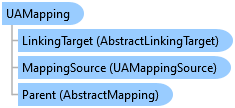

QuickOPC User's Guide and Reference
UAMapping Class


'Declaration<ComVisibleAttribute(False)> <CLSCompliantAttribute(True)> <TypeConverterAttribute(System.ComponentModel.ExpandableObjectConverter)> Public MustInherit Class UAMapping Inherits OpcLabs.BaseLib.LiveMapping.AbstractMapping
'UsageDim instance As UAMapping
[ComVisible(false)] [CLSCompliant(true)] [TypeConverter(System.ComponentModel.ExpandableObjectConverter)] public abstract class UAMapping : OpcLabs.BaseLib.LiveMapping.AbstractMapping
[ComVisible(false)] [CLSCompliant(true)] [TypeConverter(System.ComponentModel.ExpandableObjectConverter)] public ref class UAMapping abstract : public OpcLabs.BaseLib.LiveMapping.AbstractMapping
The mapping is a relation between a mapping source and a mapping target. Besides specifying which mapping source and mapping target belong together, it also specifies how and when the data is being transferred between the two.
For example, a mapping for OPC Data Access items ( DAClientItemMapping) may specify that the data is only transferred (from the source to the target) when a “Read” operation is requested (see Mapping Operations) and that the data will be in form of the value-timestamp-quality triple, i.e. a DAVtq object (see Mapping Kinds). With OPC-UA and UAClientDataMapping, the “Read” operation exists as well, and an example form of transfer may be the UAAttributeData, which contains the attribute value, status code, and timestamps. Or, the transferred data may simple be the OPC value itself.
When you annotate your objects using attributes, and then map your objects using the mapper object, the necessary mappings are created for all members of your objects that are annotated in such way. You therefore do not normally need to create mappings individually.
For OPC Data Access, there are two types of mappings that you can use:
For OPC Unified Architecture, following type of mapping exists:
System.Object
OpcLabs.BaseLib.LiveMapping.AbstractMapping
OpcLabs.EasyOpc.UA.LiveMapping.UAMapping
OpcLabs.EasyOpc.UA.LiveMapping.UAClientDataMapping